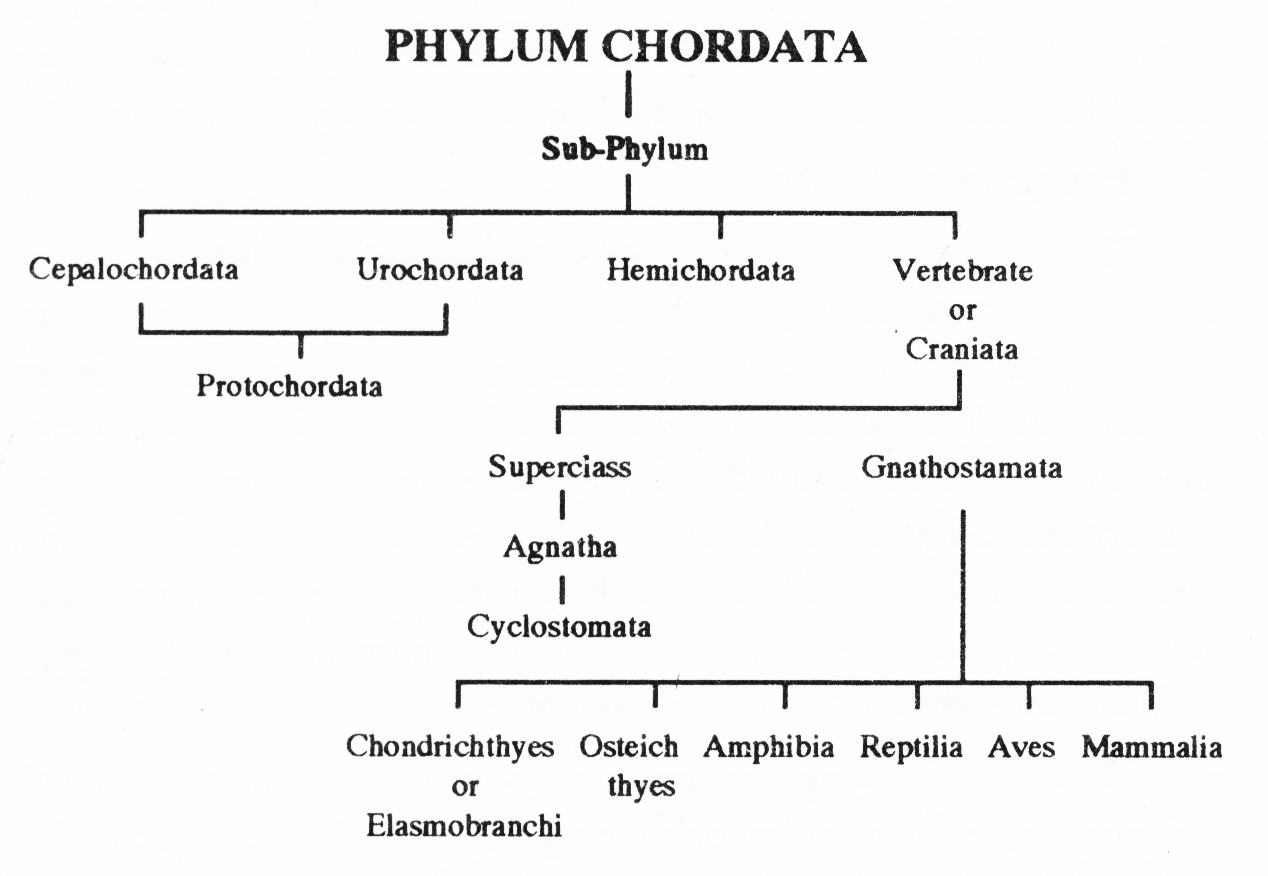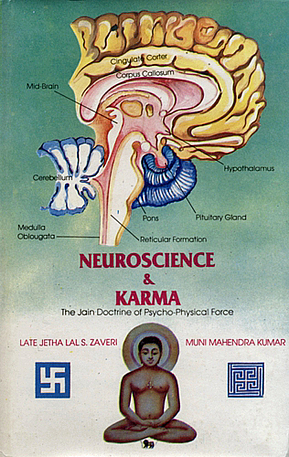0. A. Classification of Living Organisms according to the Doctrine of Karman
The Jains classify living organisms from several aspects. One of them being jāti i.e. classification based on the number of sense-organs possessed by the organism as follows:
- Ekendriya - One-sensed organisms possessed of sense of touch, e.g. plants.
- Dvīndryiya - Two-sensed organisms possessed of senses of touch and taste, e.g. worms.
- Trīndriya - Three-sensed organisms with touch, taste and smell, e.g. ants.
- Caturindriya - Four-sensed organisms with touch, taste, smell and sight, e.g. house-flies.
All these four categories do not possess a brain (i.e. they are asamjñi).
- Pancendriya - Five-sensed organisms with all the five senses including sense of hearing. They are of two types: (a) without brain (asaṁjñi) (b) with brain (saṁjñi). The latter are further subdivided into:
Deva
- celestial beings.
Naraka
- denizens of hell.
Manuṣya
- humans.
Tiryañca
- sub-human organisms.
The last are further sub-divided into
Jalacara
- aquatic animals, e.g. fish.
Sthalacara
- animals living on land (including amphibians), e.g. cattle; lizards.
Nabhacara
- birds.
0. B. Classification according to Biology
In biology, the psychic order of existence on this earth is first divided into two kingdoms - the animal kingdom and the plant kingdom. This, therefore, is the highest category and all animals are included in the animal kingdom and all plants in the plant kingdom. The biological classifications consist of a descending sequence of seven categories: (i) kingdom, (ii) phylum, (iii) class, (iv) order, (v) family, (vi) genus and (vii) species.
Species:
In the ascending sequence, species is the basic unit and the lowest category. A species is defined as a group of individuals which are genetically distinct, reproductively isolated and similar in morphological characteristics. Panthera leo, the lion and panthera tiqris, the tiger are species of the genus panthera.
Genus (PI. Genera):
A genus is an assemblage of related species and it is implied that all the species under one genus have evolved from a common ancestor. Thus panthera is the generic name for the species lion, leopard and tiger. They have many features in common and they are, therefore, included in one genus. The genus panthera is differentiated from the related genus felis which includes other wild cats such as the golden cat, the jungle cat, etc.
Family:
This catagory includes related genera and is separated from other related families by important and characteristic differences. All types of cats belonging to different genera are included under the family felidae. This family is distinctly separated from canidae which includes dogs and foxes.
Order:
This category includes related families. Therefore, both the above families are placed under the order carnivora.
Class:
This category includes the organisms of related orders, e.g., the order primates which includes man, monkey, gorilla, etc., and the order carnivora which includes the lion, the cat, the bear, the dog, etc., are included in the class mammalia. There are also a number of other orders in the class mammalia.
Phylum (PI. Phyla):
Classes of different organisms having some features in common are included in a phylum. The phylum chordata includes a number of classes such as amphibia, reptilia and mammalia. In the case of the plants, several classes constitute a division which is equivalent to the phylum of the animal kingdom.
Example:
Phylum Arthropoda is divided into four classes - Crustacea, Myriapoda, Insecta and Arachnida.
Class Crustacea - crab, prawn.
Class Myriapoda - centipedes and millipedes.
Class Insecta - butterfly, cockroach, bed-bug, mosquito, fly.
Class Arachnida - scorpion, spider.
Genus Musca - flies.
Species Musca Domestica - housefly.

1. Structure of the Brain
Let us begin our discussion with some questions: What is a brain? How does it operate? How does it know and think? How does one learn, remember and forget? How do all these processes go on in the brain while we lead our daily life? Even the most able physiologist (or neurologist) has no real answer to a single question. If the essential feature of the brain is that it contains knowledge and information, our task is to learn to translate the language it uses. However, physiologists and other neuroscientists would rather try to "understand the brain" only in the common scientific terms of Physics and Chemistry. Biochemistry and Biophysics have indeed shown an immense amount of detail about the messages that pass along nerves and the chemicals that they secrete. But it is inconceivable to describe and explain how the brain operates by giving details of these processes.
There are at least fifty thousand million (50,000,000,000) neurons in a human brain and each of these has many parts. This figure becomes even more astounding when it is realized that each neuron can interact with other neurons in not just one, but many ways - it has been recently estimated that the number of inter-connections may be as many as 10 with 800 noughts (zeros) following it. The brain has thus been aptly compared with "ten thousand million bureaucrats telephoning each other about the plans and instructions for keeping a country's affairs going".[1]
2. Programs of Life
The advent of computers and artificial intelligence with their theories and programs has given us an efficient analogy - the analogy of a program[2] which enables us to describe the functions of brain in an understandable language. Thus it can be said that our lives (and those of other animals) are controlled by sets of programs written in their genes and brains. Some of these programs ensure that we breathe, eat and sleep; some others control our growth, adulthood, senescence and death; others govern our speech and other forms of communication; still others regulate our emotions - our love and hate.
There are some long-term programs which ensure the continuity of our race. Even the most important programs used for mental activities such as thinking, planning, believing and worshipping are also there, since all our actions and thoughts come through the brain although it is difficult to say whether they come from it. In short, the brain operates in definite organized ways, called programs and results of these programs constitute the entity that we call 'personality'. To avoid too much complication, we shall ignore, as far as possible, the ultimate (transcendental) separateness of the body and soul and treat a living organism as an entity.
3. Selection of Programs
We can then say that a set of programs would mean a plan of action or activities which would be undertaken by an organism during its life-span. It would be composed (written) beforehand by karman and would, obviously, be selected from an innumerable possibilities to confirm to the particular group or class to which the organism belongs.
The selection of program will depend upon the past carrier of the individual and would be composed mainly by two out of the eight main categories of karman (See Prologue I) viz., (i) Life-span-determining (āyuṣya) karman and (ii) Body-making (nāma) karman.. Thus the programs of a human organism would be the combined work of the three selective agencies: (a) Manuṣya-āyuṣya-karman (b) Manuṣya-gati-nāma-karman and (c) Manuṣya-anupūrvī-nāma-karman.
Indeed, other selective agencies would also be concerned e.g. the culture, family etc. of the organism would be determined by the "Status-determining (gotra) karman". In the case of humans, it would also be the major determinant of his religion, legal, social and political status and language. Various other contributions to the programs of and organism would have to be made by several other selective agencies from the other major categories of karman. In fact, every division and subdivision of all the eight categories would have some influence, even if faint, in determining the brain organization and programs of what an individual would be and can do in a life-span - to love or to hate, to command or to obey and what to believe and whom to worship.
4. Translation and Transmission of Programs
Organization is the essence of a living organism. An organism continuously acts to maintain its organization because it receives from its past lives the plan or program to survive. Primarily determined by āyuṣya karman. Programs for other activities such as religion, beliefs, learning, cultural behavior etc. would be influenced and determined by other major karman. All those programs are embodied in the subtle micro-body - kārmaṇa śarīra - of the organism. The language of the program must be such that it can be translated and transmitted to produce the right actions by the gross physical body for the self-maintenance of the living system, and must be interpreted by some in-built mechanism which acts as a translator and transmitter.
Programs of vertebrate organisms (saṁjñi pancendriya) are translated on two levels:
- The basic level is inherited, written in the triplets of bases of the DNA code which is transcribed and translated during development and throughout life, enabling the organism to react appropriately with the environment.
- The second level is embodied in the structure of the brain. Its units are various groups of nerve cells which deal with breathing, eating, sleeping as well as perceiving, thinking and communicating.
Two more levels are added to these in the case of human organisms (saṁjñi Manuṣya pancendriya): - Speech, culture and mathematics represent the third level of the human life program largely embodied in the verbal spoken expression i.e. spoken and written language.
- Reasoning mind is the fourth level of the human life.
 Prof. Muni Mahendra Kumar
Prof. Muni Mahendra Kumar

